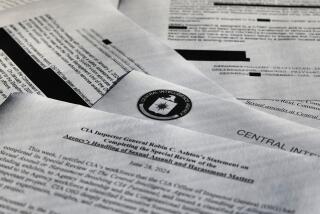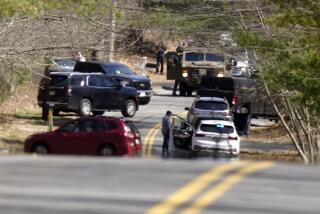CIA Chief Sees Risk of Wider Spy Problem
- Share via
WASHINGTON — In his first extensive public comments on the scandal rocking his agency, CIA Director R. James Woolsey acknowledged Thursday that discovery of what officials say is a Kremlin “mole” in the agency represents a “very serious” internal security breach and said a special commission is examining possible changes.
Woolsey, facing sometimes sharp questions from the House Intelligence Committee, said he shares lawmakers’ concerns that the spying controversy surrounding veteran CIA officer Aldrich H. Ames might be an example of a breakdown that others with sensitive access could be exploiting.
“I think that this is a very serious problem and it’s one that we take seriously and it’s one that, frankly, I fully admit,” Woolsey said.
He did not specifically address the question of whether there might be more than one mole operating in the agency, but others in Congress and around the intelligence community debated the possibilities.
Suspicions of an accomplice were fueled by classified documents found in Ames’ CIA office that had nothing to do with his assignment in the agency’s counternarcotics center.
“This doesn’t necessarily mean there was a second mole in the agency, but it may suggest that Ames had a friend or an accomplice who obtained the documents for him,” said one congressional source familiar with intelligence briefings on the case.
“The agency has very strict procedures . . , information is very compartmentalized, and it seems unlikely that he could have gotten the later documents by himself.”
But a law enforcement source close to the investigation insisted that no Americans other than Ames and his wife are suspected of taking part in the conspiracy.
An intelligence officer with Ames’ 31 years of seniority would have been able to acquire documents on assorted subjects without great difficulty, regardless of technical security restrictions, said a source familiar with CIA practices.
Anger and suspicion were pervasive in official Washington as officials both inside and outside the intelligence community tried to gauge the full extent of damage caused by spying activities that allegedly funneled sensitive information to the former Soviet Union and, later, to Russian intelligence services for nine years.
Sources confirmed that a delegation of U.S. national security officials, including a high-ranking CIA official, has been dispatched to Moscow to confer with their Russian counterparts. It is understood that the U.S. delegation wants to underscore common intelligence interests that the two countries share rather than seeking cooperation in the Ames investigation.
Investigators’ hopes that the suspects themselves would help in the damage assessment were dashed when attorneys for Ames, 52, a middle-level intelligence officer who had specialized in Soviet counterintelligence, and his wife, Maria del Rosario Casas Ames, 41, indicated that they would fight the charges. The accused CIA agent is refusing to answer questions about his alleged espionage for the Russians.
“At this point, he’s going to plead not guilty and fight the charges,” said Plato Cacheris, Ames’ court-appointed lawyer. “We’re keeping our options open.”
The veteran Washington defense attorney declined to elaborate, but a government source familiar with the case said Cacheris may have qualified his statement because of the strength of the evidence contained in an unusually detailed FBI affidavit filed in connection with searches and arrest of the couple Monday.
Maria Ames, who worked briefly as a paid CIA source in Mexico City, attacked the accuracy of quotations in the FBI affidavit--drawn from wiretaps--that depicted her as an active participant in the alleged conspiracy.
Her lawyer, William Cummings, said the part-time student at Georgetown University, “has been devastated by the distortions, out-of-context selected statements and alleged quotations in the government’s affidavit, along with the subsequent press coverage.”
When arrested Monday, she gave FBI agents a “very damaging statement,” a source familiar with the investigation said Thursday. An aide to Cummings declined comment on her interview by FBI agents and whether it signaled that she is cooperating with investigators.
But another source said there has been no further cooperation after the initial interview.
In his appearance on Capitol Hill, Woolsey faced questions heavily laced with disbelief that an intelligence officer with access to such extremely sensitive information--including the code names of Russians spying for the United States--could have escaped notice while living far beyond his means and making unauthorized travel overseas.
“He may not have been alone in recognizing that the system may not have been operating, that discovery is not certain, that procedures were not working,” said Rep. Robert G. Torricelli (D-N.J.).
Rep. Dan Glickman (D-Kan.), chairman of the House panel, said the Ames case “raises disturbing questions about the internal controls and management of counterintelligence activities at the CIA.”
Woolsey said a joint CIA-Defense Department commission appointed last year is currently studying security-related issues and would be making its recommendations shortly.
“This commission, among other things, has looked carefully into such matters as reliance on the polygraph, focusing on the financial status of individuals in the government by way of keeping track of security matters and the rest,” Woolsey said.
Amid reports that Ames passed CIA polygraph tests in 1986 and 1991, Woolsey said: “There are important changes that need to be made in . . . security policy.”
Speculation about the possibility of another mole or an Ames confederate remaining in the CIA were heightened by a government affidavit on a June 25, 1993, search of Ames’ office by the FBI. It turned up many restricted documents that had “no relationship to Ames’ current duties as an operations officer in the Counternarcotics Center,” said the document, which was made public Tuesday.
More to Read
Sign up for Essential California
The most important California stories and recommendations in your inbox every morning.
You may occasionally receive promotional content from the Los Angeles Times.












